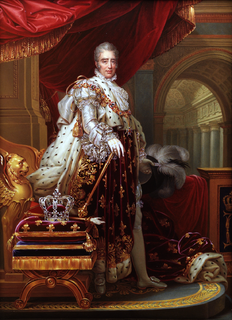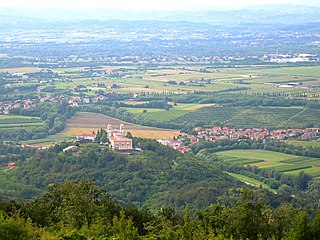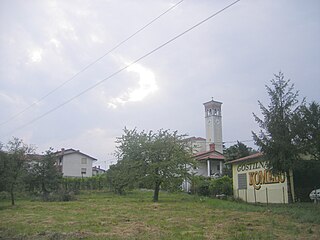| Pristava Rafut | |
|---|---|
| Coordinates: 45°56′53.55″N13°38′6.9″E / 45.9482083°N 13.635250°E Coordinates: 45°56′53.55″N13°38′6.9″E / 45.9482083°N 13.635250°E | |
| Country | |
| Traditional region | Slovenian Littoral |
| Statistical region | Gorizia |
| Municipality | Nova Gorica |
| Area | |
| • Total | 0.47 km2 (0.18 sq mi) |
| Elevation | 105.3 m (345.5 ft) |
| Population (2002) | |
| • Total | 361 |
| [1] | |
Pristava (pronounced [pɾiˈstaːʋa] ; Italian : Prestava, Friulian : Rafût, German : Prestau), also known locally as Rafut (pronounced [ɾaˈfuːt] [2] ), is one of the four suburbs of the town of Nova Gorica in the Gorizia region of western Slovenia (the other three are Solkan, Rožna Dolina, and Kromberk). [3]

Italian is a Romance language of the Indo-European language family. Italian, together with Sardinian, is by most measures the closest language to Vulgar Latin of the Romance languages. Italian is an official language in Italy, Switzerland, San Marino and Vatican City. It has an official minority status in western Istria. It formerly had official status in Albania, Malta, Monaco, Montenegro (Kotor) and Greece, and is generally understood in Corsica and Savoie. It also used to be an official language in the former Italian East Africa and Italian North Africa, where it plays a significant role in various sectors. Italian is also spoken by large expatriate communities in the Americas and Australia. Many speakers of Italian are native bilinguals of both standardized Italian and other regional languages.
Friulian or Friulan is a Romance language belonging to the Rhaeto-Romance family, spoken in the Friuli region of northeastern Italy. Friulian has around 600,000 speakers, the vast majority of whom also speak Italian. It is sometimes called Eastern Ladin since it shares the same roots as Ladin, but, over the centuries, it has diverged under the influence of surrounding languages, including German, Italian, Venetian, and Slovene. Documents in Friulian are attested from the 11th century and poetry and literature date as far back as 1300. By the 20th century, there was a revival of interest in the language that has continued to this day.

German is a West Germanic language that is mainly spoken in Central Europe. It is the most widely spoken and official or co-official language in Germany, Austria, Switzerland, South Tyrol (Italy), the German-speaking Community of Belgium, and Liechtenstein. It is also one of the three official languages of Luxembourg and a co-official language in the Opole Voivodeship in Poland. The languages which are most similar to German are the other members of the West Germanic language branch: Afrikaans, Dutch, English, the Frisian languages, Low German/Low Saxon, Luxembourgish, and Yiddish. There are also strong similarities in vocabulary with Danish, Norwegian and Swedish, although those belong to the North Germanic group. German is the second most widely spoken Germanic language, after English.
Between the late 18th century and 1947, it used to be a suburb of the town of Gorizia (now in Italy). When the city was partitioned in 1947, most of the city center remained in Italy, while its eastern suburbs were annexed to Yugoslavia. Part of Pristava (Rafut) remained in Italy, and while part of it became part of Slovenia. In some cases, the border was drawn literally between individual houses. Until Slovenia's entry into the Schengen zone in 2007, a local border pass functioned in Pristava. [4]

Gorizia is a town and comune in northeastern Italy, in the autonomous region of Friuli Venezia Giulia. It is located at the foot of the Julian Alps, bordering Slovenia. It is the capital of the Province of Gorizia and a local center of tourism, industry, and commerce. Since 1947, a twin town of Nova Gorica has developed on the other side of the modern-day Italian–Slovenian border. The entire region was subject to territorial dispute between Italy and Yugoslavia after World War II: after the new boundaries were established in 1947 and the old town was left to Italy, Nova Gorica was built on the Yugoslav side. Taken together, the two towns constitute a conurbation, which also includes the Slovenian municipality of Šempeter-Vrtojba. Since May 2011, these three towns have been joined in a common trans-border metropolitan zone, administered by a joint administration board.

Italy, officially the Italian Republic, is a European country consisting of a peninsula delimited by the Italian Alps and surrounded by several islands. Located in the middle of the Mediterranean sea and traversed along its length by the Apennines, Italy has a largely temperate seasonal climate. The country covers an area of 301,340 km2 (116,350 sq mi) and shares open land borders with France, Slovenia, Austria, Switzerland and the enclaved microstates of Vatican City and San Marino. Italy has a territorial exclave in Switzerland (Campione) and a maritime exclave in the Tunisian sea (Lampedusa). With around 60 million inhabitants, Italy is the fourth-most populous member state of the European Union.
The Kostanjevica Monastery, in which Charles X of France is buried, is located on a hill above the settlement.

Kostanjevica Monastery is a Franciscan monastery in Pristava near Nova Gorica, Slovenia. The locals frequently refer to it simply as Kapela.

Charles X was King of France from 16 September 1824 until 2 August 1830. For most of his life he was known as the Count of Artois. An uncle of the uncrowned Louis XVII and younger brother to reigning kings Louis XVI and Louis XVIII, he supported the latter in exile. After the Bourbon Restoration in 1814, Charles became the leader of the ultra-royalists, a radical monarchist faction within the French court that affirmed rule by divine right and opposed the concessions towards liberals and guarantees of civil liberties granted by the Charter of 1814. Charles gained influence within the French court after the assassination of his son Charles Ferdinand, Duke of Berry, in 1820 and eventually succeeded his brother in 1824.














